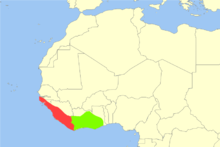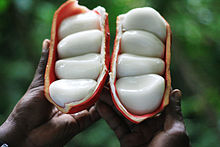Leo monkey
| Leo monkey | ||||||||||||
|---|---|---|---|---|---|---|---|---|---|---|---|---|

Leo monkey ( Cercopithecus lowei ) |
||||||||||||
| Systematics | ||||||||||||
|
||||||||||||
| Scientific name | ||||||||||||
| Cercopithecus lowei | ||||||||||||
| Thomas , 1923 |


The Leo monkey ( Cercopithecus lowei ) is a species of primate from the genus of the monkeys ( Cercopithecus ) within the family of the vervet monkeys (Cercopithecidae). These animals live in western Africa in the states of Ivory Coast and Ghana , east to the Volta . The Leo monkey is closely related to the Campbell's monkey ( C. campbelli ) and is sometimes considered a subspecies thereof. Both species hybridize with each other near Guiglo between Cavally and Sassandra .
features
Leo monkeys have blackish brown fur on top , often with an orange or red-gold tinge. The underside is lighter, almost whitish. The blue-gray face is surrounded by gray whiskers, the area of the mouth is reddish in color. The top of the head is covered with yellow and auburn hair. The outside of the arms and legs are dark gray to blackish. The tail is black at the base and in the rear third, in between the underside is light yellowish.
Their head body length is 45 to 52 (males) or 40 to 43 centimeters (females), in addition there is a long tail, which in the males can be 66 to 75 centimeters long, while that of the females reaches 54 to 58 centimeters. The weight of adult females is 2 to 3.8 kilograms, while the significantly heavier males reach 5.2 to 5.8 kilograms.
habitat
The Leo monkey is one of the most common forest-bound meerkats in West Africa and lives in evergreen, primary rainforests, in secondary forests , gallery forests , north of the rainforest zone in isolated forests in savannahs (e.g. in the Buabeng-Fiema monkey reserve in central Ghana) and in bushland in the midst of agriculturally used regions. It is rare in swampy forests and mangroves . Leo monkeys are inhabitants of the lowlands, most of the animals occur below a height of 150 meters, a few at heights of up to 300 meters. The prerequisite for the occurrence of Leo monkeys is an average annual rainfall of 1200 to 2500 mm.
Way of life

Not much is known about the way of life of this species, but it should agree with that of other monkeys. She is therefore a diurnal tree dweller who lives in harem groups. These consist of a male, several females and their young, usually a total of 6 to 12 animals. Mixed groups are formed with the Diana monkey ( C. diana ) and the small white-nosed monkey ( C. petaurista ). The groups are often accompanied by the white-headed hornbill ( Tropicranus albocristatus ). The monkeys benefit from the alarm calls of the white-headed hornbill. He follows them in the food trains and eats the small animals (mostly insects) that they scare off. The territory that a group inhabits is on average 40 hectares , but in remaining forest areas often only 3 to 14 hectares are sufficient. The diet consists mainly of fruits, including those of colas and figs , leaves, seeds, flowers, bark, locusts and insect larvae. They often drink water from tree holes by dipping their hand in and then licking the wet hand. Playfully they deal with other animals, e.g. B. with ants or frogs, or playfully hunt gray-footed squirrels ( Heliosciurus gambianus ), pigeons , black kites ( Milvus migrans ) or magpie tokos ( Tockus fasciatus ). Females reach sexual maturity at three years of age, males at four years of age. The gestation period is 147 to 180 days, the individual young are weaned after about 180 days. There are no reports of twin births. Most matings take place after the long rainy season, the coolest time of the year, from June to September, most births occur after the short rainy season at the beginning of the main dry season in December or January. The maximum determined age is 28 years.
Predators that hunt down the Leo monkeys include crowned eagles , leopards, and chimpanzees .
Hazard and protection
The IUCN lists the Leo monkey as not endangered because the species is widespread and can adapt to different habitats. In Ghana and the Ivory Coast, the species occurs in 13 of the total of 19 protected areas, including the Kakum National Park and the Buabeng-Fiema Monkey Conservation Reserve in Ghana.
literature
- Thomas Geissmann : Comparative Primatology. Springer-Verlag, Berlin et al. 2003, ISBN 3-540-43645-6 .
- Don E. Wilson, DeeAnn M. Reeder (Eds.): Mammal Species of the World. A taxonomic and geographic Reference. Johns Hopkins University Press, Baltimore MD 2005, ISBN 0-8018-8221-4 .
Individual evidence
- ↑ a b c d Anh Galat-Luong. Gérard Galat, Mary E. Glenn & W. Scott McGraw: Cercopithecus lowei Lowe's Monkey pages 325–327 in Thomas Butynski , Jonathan Kingdon and Jan Kalina (eds.): Mammals of Africa Volume II. Primates. Bloomsbury, London, 2013, ISBN 978-1-4081-2252-5
- ↑ a b c d e f Elizabeth L. Gadsby, Colin P. Groves, Aoife Healy, K. Praveen Karanth, Sanjay Molur, Tilo Nadler, Matthew C. Richardson, Erin P. Riley, Anthony B. Rylands, Lori K. Sheeran , Nelson Ting, Janette Wallis, Siân S. Waters & Danielle J. Whittaker: Family Cercopithecidae (Old World Monkeys). Pages 682-683 in Russell A. Mittermeier , Anthony B. Rylands & Don E. Wilson : Handbook of the Mammals of the World: - Volume 3. Primates. Lynx Editions, 2013 ISBN 978-8496553897
- ↑ JF Oates, S. Gippoliti and CP Groves: Cercopithecus lowei , 2008. IUCN Red List of Threatened Species Version 2010.4; Retrieved February 25, 2011